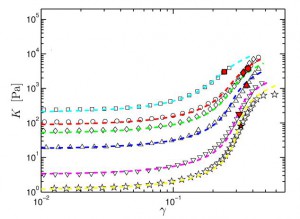How do collagen networks protect biological tissues from damage?
The Biological Soft Matter group of Gijsje Koenderink published a paper in Nature Physics in which they report a new model that explains the remarkable mechanical strength of collagen matrices.
Collagen is the principal load-bearing polymer in all connective tissues ranging from skin to bone. Collagen networks strongly stiffen when a mechanical force is applied, thus preventing excessive deformation of the tissue. The new model explains this strain-stiffening behavior by modeling collagen matrices as networks of connected elastic beams. Mechanical loads will cause these networks to stiffen by stretching and thus tightening the fibers. The new model provides a quantitative framework to predict the mechanics of tissues and also guidelines to design new synthetic materials that mimic the unique mechanics of tissues. The work was carried out in close collaboration with the MacKintosh group of the VU University.
Mechanical stabilization of tissues by collagen
All connective tissues in the human body, ranging from skin and cartilage to tendon and even bone, owe their mechanical strength to fibrous networks made up of collagen. It has been experimentally known for decades that collagen networks strongly stiffen when a mechanical load is applied. This strain-stiffening response prevents tissue damage by blocking large deformations. The groups of Koenderink and MacKintosh joined forces to explain this mechanical stabilization in terms of the characteristic fibrous architecture of collagen networks. The MacKintosh group proposed a theoretical model that models the collagen fibers as elastic beams characterized by a rigidity against stretching and bending. The model predicts that such networks easily deform under a small mechanical load, because the beams can easily bend. Large loads will, however, reorient and straighten the fibers, causing a transition from a flexible to a rigid state.
Fishnet
An everyday analogy is the rigidity of a fishnet, which is completely flexible in its relaxed state but stiffens when it is pulled up. The main difference between collagen networks and fishnets is that collagen fibers are stiffer than the filaments in a fishnet, which stabilizes the network even at small deformations. To test the model, the Koenderink group assembled networks of purified collagen in the lab, and measured the mechanical resistance of these networks to an imposed deformation in a rheometer. The experiments demonstrated that the new model can very accurately predict the stiffness of collagen networks for deformations ranging from minute to the rupture point.AMOLF group leader Gijsje Koenderink: “This combination of theory and experiment provides the first compelling demonstration of the underlying mechanism of collagen network mechanics.”
Surprising analogy to magnets
Surprisingly, the physical principle that governs the response of collagen networks to an applied mechanical load is closely related to models of the ferromagnetic phase transition in magnets. In analogy to magnets, strain-stiffening can be seen as a phase transition with a characteristic critical point corresponding to the strain where the collagen fibers all start to stretch instead of bend. Since this is a general mechanism that is independent of the chemical composition of collagen, this provides a new route to create synthetic fibrous materials with collagen-like properties. Such materials could find use as artificial tissues to repair damaged or lost tissues.
Reference
A. Sharma, A.J. Licup, K.A. Jansen, R. Rens, M. Sheinman, G.H. Koenderink & F.C. MacKintosh, Strain-controlled criticality governs the nonlinear mechanics of fibre networks Nature Physics (2016)
Read more >> VU news

Electron microscopy image of collage network. The long and stiff fibers in the network are made up by collagen molecules.

Graph showing that the measured increase of the stiffness of collagen networks (shown on the vertical axis) with increasing network deformation (shown on the horizontal axis) agrees precisely with the predictions of the new theoretical model (shown by the lines).


